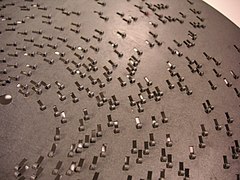Polyphonic (jukebox)
Polyphon is the brand name of a self-playing mechanical musical instrument that was manufactured by Polyphon-Musikwerke AG in Wahren near Leipzig around the turn of the century. The term polyphonic comes from ancient Greek. πολύ polý "much" and φωνή phonḗ "voice", that is, "polyphonic".
Company history
The polyphonic music works were in 1889 under the Company Fallow Hausen & Rießner founded by Gustav Adolph fallow Hausen (1860-1943) and Ernst Paul Rießner. Both were previously employed by the rival company Symphonion and had "taken" technical knowledge from there, which the owner of Symphonion, Lochmann, tried in vain to prevent.
The Brachhausen & Rießner company exhibited their “Polyphon” for the first time at the Leipzig Autumn Fair in 1890. The trademark was registered in 1891 and shows a woman with a lyre and laurel wreath under a comet . The company obtained a total of seven patents and 12 utility model registrations between 1890 and 1894 . At the world exhibition in Antwerp in 1894, the polyphonic devices were awarded a silver medal. On April 1, 1895 the company was changed to Polyphon Musikwerke AG. The devices were also exhibited at the Paris World Exhibition in 1900 . Around 1900 the company employed around 800 people and achieved an annual production of 40,000 instruments.
In 1904 Polyphon Musikwerke presented the first unbreakable record made of sheet metal with a celluloid coating . On July 25, 1914, the Polydor brand was registered for musical instruments, sheet music, rollers, records and apparatus. On April 24, 1917, Polyphon Musikwerke AG acquired the shares of Deutsche Grammophon AG, which was under administration as enemy assets , and the company was then changed to Polyphonwerke AG. The further history of the Polyphonwerke is also that of Deutsche Grammophon.
function
The functional principle of the polyphonic perforated plate consists of a metal plate with punched elongated holes that form small hooks on the underside. These hooks, in turn, turn on toothed cogs that tear metal lamellae on the so-called tuning comb and thus produce a sound. The polyphonic had a spring mechanism that had to be wound with a crank.
The melodies were applied to perforated panels that could easily be exchanged. Perforated panels were available in different sizes and with different lengths of play. For example, a perforated plate with a diameter of 28 cm had a playing time of approximately one minute.
Larger instruments were designed as coin-operated machines for installation in restaurants. They offered the customer the choice between twelve different melodies. After inserting the coin, the record with the desired melody was automatically lifted from the magazine into the game mechanism, played and stowed back in the magazine.
photos
A polyphonic in the Lithuanian Theater, Music and Cinema Museum
Individual evidence
- ^ Brachhausen & Riessner.
- ↑ Shellac record label - Polyphonic.
- ^ The polyphonic musical works at the Paris World Exhibition in 1900. Retrieved on May 6, 2015 .







